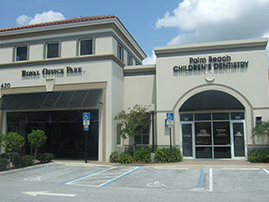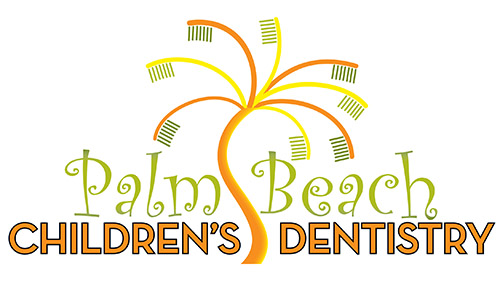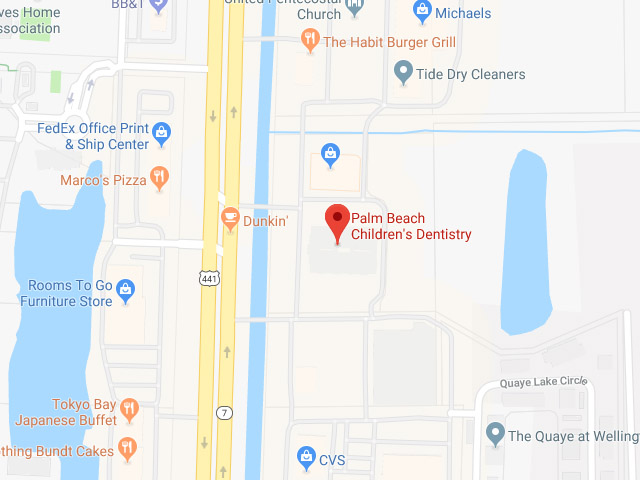Pediatric Dental Emergencies
The following information is only a reference for your convenience and is not to be a replacement for a proper dental examination. Please be advised that you should always follow-up with our office during business hours at (561) 798-4998. In the event your child is experiencing a life threatening dental emergency, please refer to your nearest emergency clinic or hospital. (Palms West or St. Mary’s have dental capabilities). For a permanent tooth that has been knocked out or a severely swollen area, email us at pbcder@gmail.com, so that we may guide you through it.
Numbness and Tissue Biting (Cheek, Lip or Tongue)
The Signs Of Trauma From A Bite Are:
A swollen lip, cheek or tongue (which can appear as much as 3x larger than normal)
A raw lip surface, often bite marks or abrasions can be seen on the inside of the lip or cheek
The affected area may be appear to be red in color, tender and sensitive
The following day, the surface may be covered by a yellowish-white membranous “scab”
What To Do:
Keep your child well fed and hydrated
Popsicles and other frozen items may be comforting/soothing
Cold liquids are best-Milkshakes and slushies are a good, fun option for this!
Avoid acidic and/or spicy juices or foods
Normal healing will require 10-14 days & antibiotics are not usually necessary
Please call our office the next business day so we may schedule an appointment to follow-up with your child.
Following this, children begin to lose their baby (or primary) teeth and the adult teeth start to erupt. This is a cause of teething pain in older children. Permanent or adult teeth begin to erupt from the age of around 6 years old and go on anywhere until 21 years of age or beyond, when the wisdom teeth come in.
For Infants/Toddlers:
Giving the child something hard to chew, like teething biscuits, rubber teething rings and cool teething rings, can be helpful. The teething device should be large enough to not pose a choking hazard. Avoid using teething rings filled with liquid, since these can break or leak. Do not freeze the rings to rock hard, since this can cause even more tender gums when the child bites on them. Wet washcloths that have either been placed in the fridge or freezer are helpful to babies with teething pain. You can use the washcloth to swab and massage the gums. Make sure to wipe away any drool on the face, since prolonged contact of saliva with skin can cause rashes in some children.
For Older Teething Children:
Over-the-counter children’s pain medication, dosed according to your child’s weight and age, will ease the symptoms of pain, but use on an as-needed basis.
Sometimes a purplish “bubble-like” appearance can form around the area where the tooth is erupting. Keep your child on a soft diet and call our office the next business day to schedule an evaluation.
If lip or any area is swollen due to the trauma, apply a cold compress.
Keep your child on a soft diet for 2-3 days and avoid any spitting or sucking.
The baby tooth should not be replanted because of the potential for subsequent damage to the developing permanent tooth.
If a baby tooth has been injured and is extremely loose, it is best to try to remove the tooth to avoid the child aspirating it. This can be performed by using a washcloth or paper towel to grasp the tooth and removing it in a swift twisting motion.
Please SEEK CARE AT YOUR PEDIATRICIAN’S OFFICE OR LOCAL EMERGENCY CLINIC/HOSPITAL to have all physical injuries evaluated.
Please call our office the next business day so we may schedule an appointment to follow-up with your child.
**You can send us an email at pbcder@gmail.com so that we can guide you through the next steps.
If possible, replace the tooth in the socket immediately and hold it with a wash cloth or gauze. The best chance for the tooth is for it to be replanted within 5 minutes of being knocked out.
If you are unable to put the tooth back in the socket, place the tooth in a clean container with cold milk, saliva or water.
**CALL OUR OFFICE IMMEDIATELY IF DURING BUSINESS HOURS.
**IF CALLING AFTER BUSINESS HOURS, PLEASE SEEK EMERGENCY CARE AT YOUR NEAREST EMERGENCY CLINIC OR HOSPITAL. Then, follow up with our office by leaving a voicemail and we will return your call the next business day.
**You can send us an email at pbcder@gmail.com so that we can guide you through the next steps.
Over-the-counter children’s pain medication, dosed according to your child’s weight and age, will ease the symptoms of pain. Brushing, flossing, and a mild salt water rinse in the area may help relieve any discomfort resulting from food and debris trapped in the area.
IF SWELLING OF THE FACE HAS OCCURRED, apply a cold compress or ice wrapped in a cloth, to the face in the location of the swelling and SEEK EMERGENCY CARE AT YOUR NEAREST EMERGENCY CLINIC OR HOSPITAL IMMEDIATELY.
IF YOUR CHILD’S FACE IS SWOLLEN AND IS HAVING DIFFICULTY BREATHING OR THE SWELLING HAS CHANGED THE APPEARANCE OF THE FACE, SEEK EMERGENCY CARE AT YOUR NEAREST EMERGENCY CLINIC OR HOSPITAL IMMEDIATELY.
Then, please call our office the next business day, so we may schedule an appointment to follow-up with your child.
**If there is a severely swollen area, you can send us an email at pbcder@gmail.com so that we can guide you through the next steps.
If your child is experiencing discomfort, over-the-counter children’s pain medication, dosed according to your child’s weight and age, will ease the symptoms of pain.
Control the bleeding (if any) by applying pressure (either by having the child bite down on a gauze or wash cloth or if they refuse to bite down, hold gauze or wash cloth in place for them) until the bleeding subsides.
If lip or any area is swollen due to the trauma, apply a cold compress. Check the lip to see if any tooth fragments are embedded. If so, try to remove fragments from the lip gently.
Keep your child on a soft diet 2-3 days and with room temperature food and water.
If it is a permanent tooth and a significant part of the tooth is missing, try to save the fractured portion in a zip lock bag with milk or water and bring it with you to your appointment.
Please contact our office during business hours, so we may schedule an appointment to follow-up with your child and possibly restore the tooth.
**IF CALLING AFTER BUSINESS HOURS, PLEASE SEEK EMERGENCY CARE AT YOUR NEAREST EMERGENCY CLINIC OR HOSPITAL. Then, follow up with our office by leaving a voicemail and we will return your call the next business day.
Contact Palm Beach Children’s Dentistry

420 South State Road 7, Suite 140
Royal Palm Beach, FL 33414
Phone:
561-798-4998
Fax:
561-798-4996
Email:
drameer@pbchildrensdentistry.com
Emergency Email:
pbcder@gmail.com
Request an Appointment
Provide your information below along with the date and time requested.

